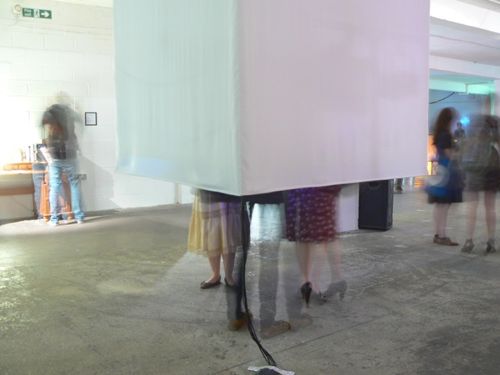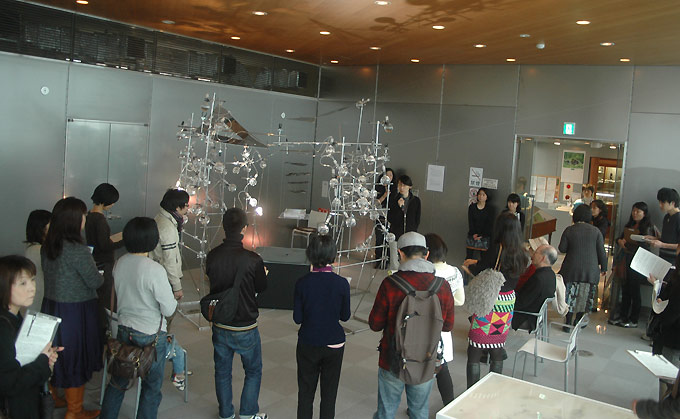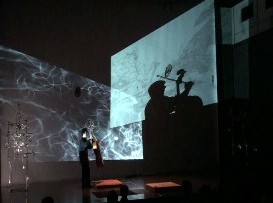Thorbjørn Lausten
9. Juni 2010
Electrum, shows a large neon work next to an U Bahn station in Hamburg. The red cross was permanently switched on, day and night, and when a train passed, the noise of the train switched on the rest of the work.
Thorbjørn Lausten
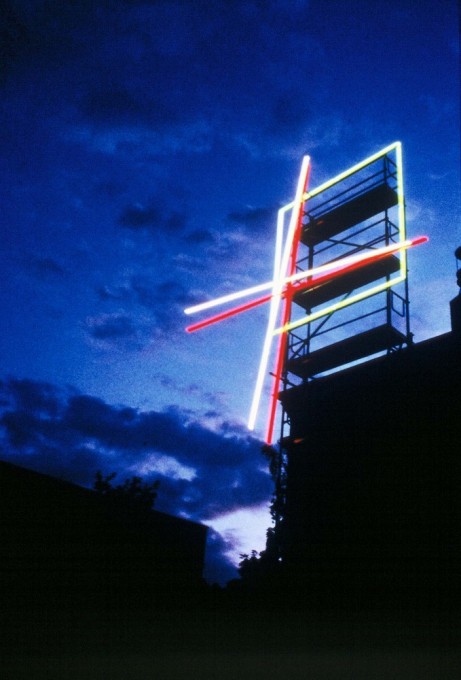
Carlo Bernardini
4. Juni 2010
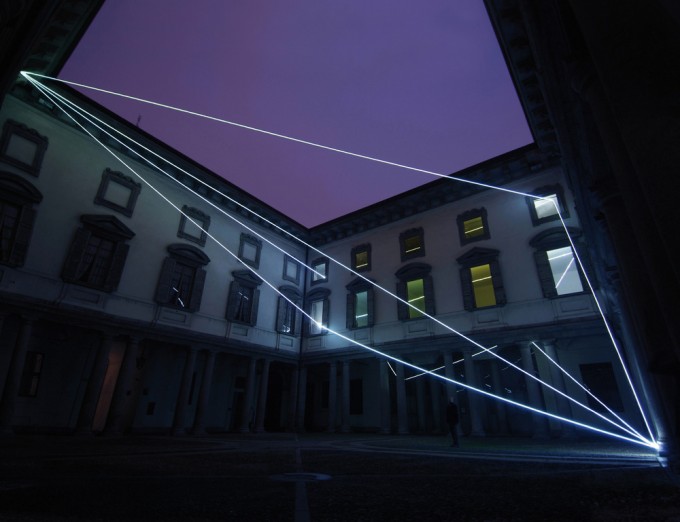
THE LIGHT THAT GENERATES SPACE
A drawing paper is simply paper as long as it is white, but once you draw on it, it becomes “a drawing”. A design in light is a mental drawing that uses a dark space, as a kind of dark paper on which it forms in negative. An optical fibre drawing in space can be in harmony with the place itself, but the light can also create an interrelation by overcoming the physical walls and transforming the environment in a deceptive way. An installation, in fact, has the power to take the space and push it to the limit of an illusionary dimension, the one dictated by the original idea. A mental drawing, executed with the light of the optical fibre, can go beyond the walls, not allowing the viewer to understand its origin. The lines of light passing through the walls connect different rooms, joining them in the space of a single work, which lacking a complete point of view, in its wholeness can only be reconstructed as a puzzle in the viewer’s mind. The installation takes over the space and incorporates it. The spatial form develops a challenging relationship with the space, as it penetrates it, stimulates it and reduces to its power, until transforming it into itself. It is a role play where the space is transformed from the container into the artwork: the drawing of light goes through it penetrating it, and once inside, it goes beyond the walls without the solution of continuity. The optical fibre line passes from room to room piercing the walls and the floors, combining the external environment with the internal one in a sole drawing: “Permeable space”, the place where Light generates space.
Carlo Bernardini Milan 2009
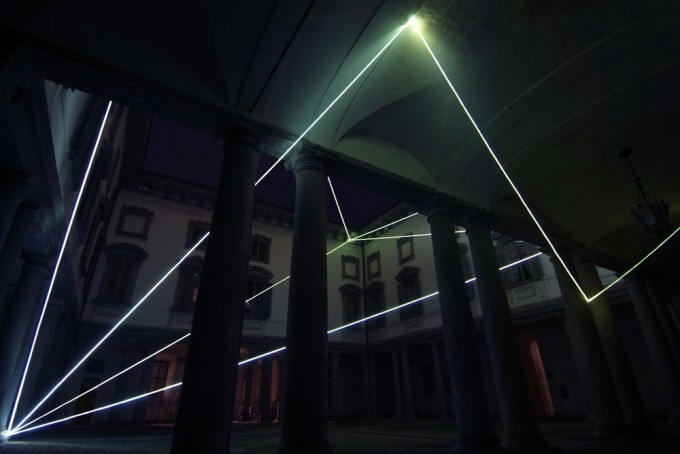
Images script:
THE LIGHT THAT GENERATES SPACE 2009
Installation in optic fibers, feet h 66 x 88 x 99.
Milan, Palazzo Litta.
www.carlobernardini.it
Fabrizio Corneli
3. Juni 2010
Fabrizio Cornelis bildnerische Arbeit ruht im kunsthistorischen Fundus der italienischen Hochrenaissance und ist eine ästhetische Synthese präziser geometrischer Berechnungen und philosophischer Reflexionen über die Wahrnehmung… Der Künstler hat das in der Renaissance und im Manierismus geborene Prinzip der Anamorphose, der Umgestaltung und Verzerrung, aufgegriffen und konsequent in das 21. Jahrhundert übersetzt. Nicht mehr der spezielle Standort lässt den Betrachter nun das Zerrbild korrigieren, sondern die gezielte Lichtvorgabe aus der Steckdose. Wer sehen will, braucht Licht. Licht wird benötigt, um die Dinge sichtbar zu machen… Licht, so führt es Fabrizio Corneli fort, ist die reinste Form der Energie. Licht wird bei seinen Arbeiten nicht nur als Erscheinungsmittel gebraucht, das aus dem Verborgenen formal reduzierte Abbilder von der Wirklichkeit auf die weissen Wände schickt. Licht und Schatten werden in seinen objekthaft-skulpturalen Licht-Schattenbildern vielmehr selbst zum Bild und zum Thema der Reflexion.
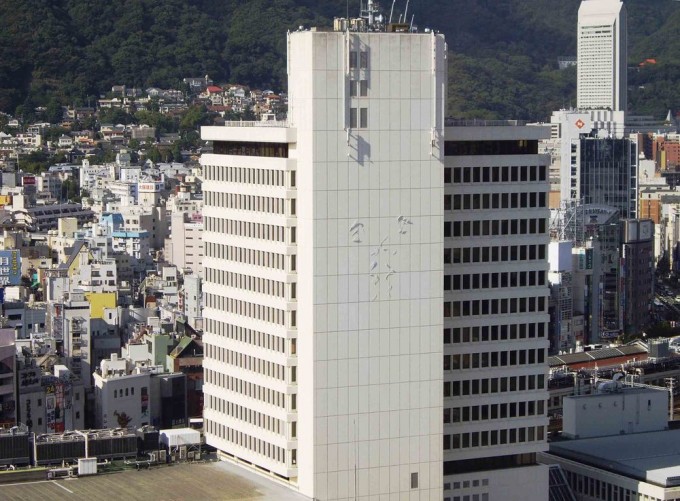
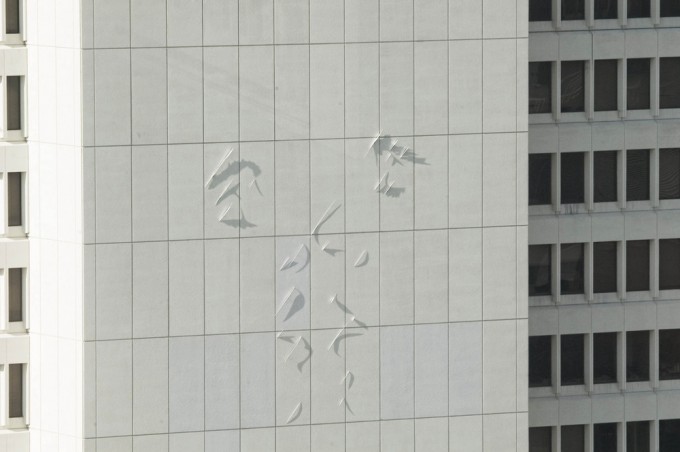
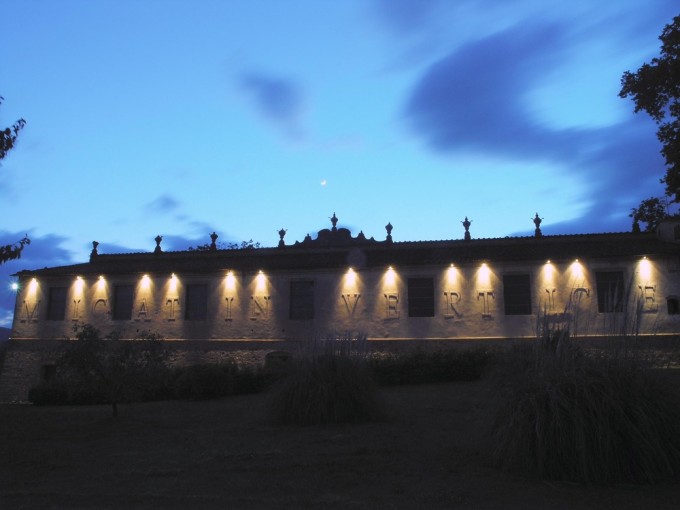
… Er setzt mit seinem künstlerischen Impuls das Spannungsfeld menschlicher Wahrnehmung in der ganzen Bandbreite zwischen Irrtum und Erkenntnis ‚ unter Strom ‚ und lässt das Sehen, Versuchen, Erfahren, Erkennen und Begreifen wieder zu einem bewussten Prozess wie zu einem sinnlichen Abenteuer werden. Denn irgendwann geht es dem Betrachter nicht mehr um die gesehenen Bilder aus Licht und Schatten, sondern um die Geheimnisse und die stille magische Kraft einer amorphen Technik und Ästhetik – um einen alten Zauber, der auch den modernen Menschen, der alles zu erklären gewohnt ist, erst einmal in die Irre führt, nachdenklich macht und zur Reflexion über den Ursprung des Gesehenen bewegt. Dabei stellt es Corneli seinem Publikum frei, ob es über Wissen, Erfahrung, Assoziation oder Fragen die Quellen dieser Bilder ergründet. Corneli versteckt seine Anamorphosen nicht: Er legt sie als eine Art offene Kunst an, um dem Betrachter einen möglichst freien Zugang zu ermöglichen.
(Text: Thomas Kriegisch)
www.fabrizio-corneli.com
Juanli Carrión
1. Juni 2010
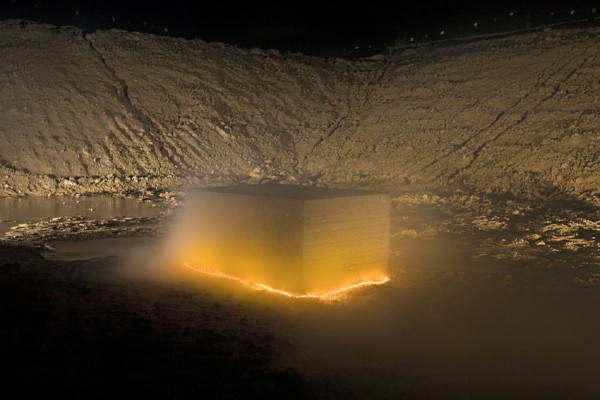
Kei-Seki, Juanli Carrión
Patrice Warrener
29. Mai 2010
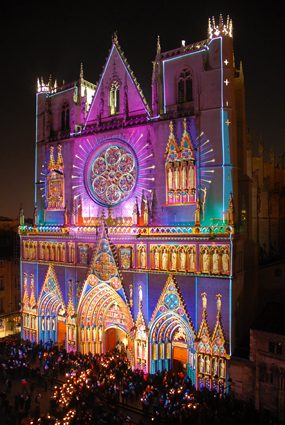
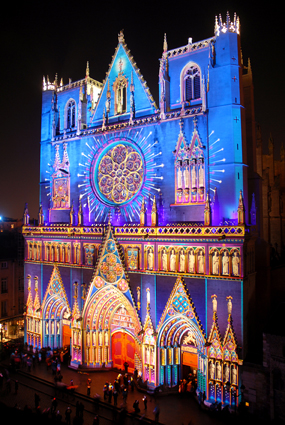
Silvia Gröbner
26. Mai 2010
Lichtobjekt: Rotlicht des Lebens
von Silvia Gröbner
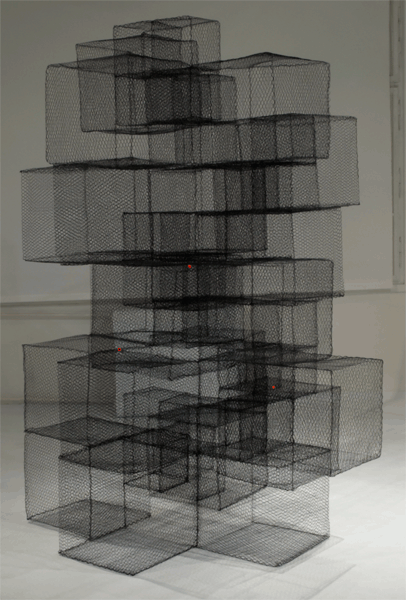
Rotlicht des Lebens
Ein Gedankenspiel zur Quantenphysik, Philosophie, Kunst
Projekt-Beschreibung:
und Mystik
In den 20er Jahren des vorigen Jahrhunderts wurde vom russischen Biologen Alexander Gurwitsch eine schwache elektromagnetische Strahlung in lebenden Zellen entdeckt. Auch die menschliche DNA ist nach F.A. Popp (International Institute of Biophysics ) und Prof. Herbert Klima (Atominstitut der TU Wien) eine Lichtquelle und ein Biophotonenspeicher. Ein interessanter Aspekt ergibt sich aus der empirisch belegbaren Tatsache, dass in Körperzellen durch diese schwache elektromagnetische Strahlung (z.B. als pulsierendes, dunkelrotes Licht bei einer Wellenlänge von ca. 630 nm) ein Informationsaustausch auch ohne Beteiligung chemischer Botenstoffe stattfindet. Das Lichtobjekt, bestehend aus 56 Drahtgitterwürfeln, insgesamt ca. 1,5m X 1,5m X 2,50m , erwächst aus der physikalischen Tatsache, dass die uns umgebende Materie durch Lichtquanten verbunden und organisch durch pulsierende Biophotonen geordnet wird. Die Gitterstruktur der Würfel erinnert daran, dass auch der materielle Körper als Gerüst für ein freies, schöpferisches Bewusstsein gesehen werden kann:
Das Bewusstsein wird durch ein von innen heraus pulsierendes Licht dargestellt.
– Silvia Gröbner, Mai 2010
Pomodoro Bolzano
26. Mai 2010
vintage 2003 | biomorph multiple,
3 pcs (sicilian cherry tomato, silicone rubber)
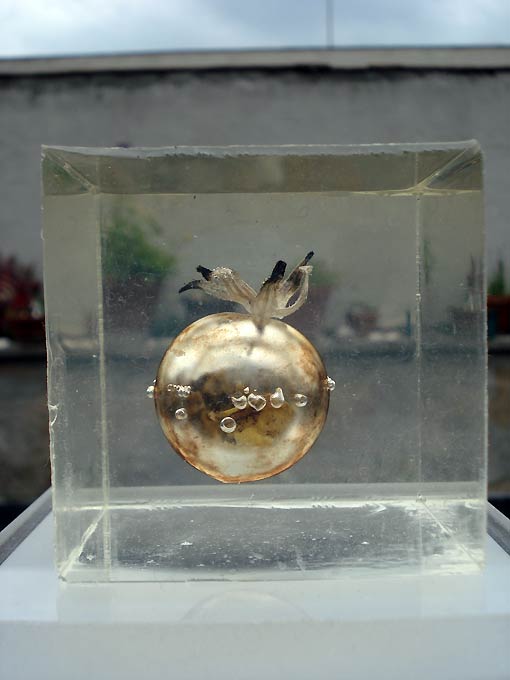
Pomodoro Bolzano are Max D. Well, Christian Wittkowsky, Andreas Müller und Detlef Thomas
http://derblauedynamo.blogspot.com http://artclouds.blogspot.com http://xxxtenxion.blogspot.com http://artthinkbox.blogspot.com www.pbspace.de www.artbirthday.com
Hideo Iwasaki
25. Mai 2010
Paperworks – Biomedia Art by Hideo Iwasaki, Tokyo
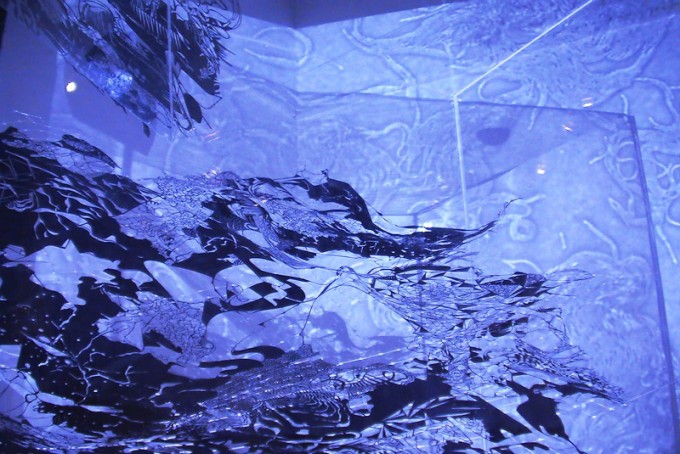
Galerie Wuensch http://artmarket.at
http://www.hollandpapierbiennale.nl
http://www.f.waseda.jp/hideo-iwasaki/english.html
Alexandre Murucci
21. Mai 2010
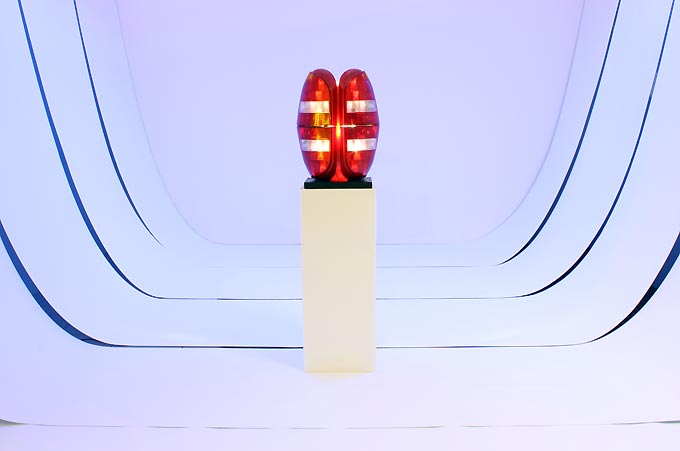
Alexandre Murucci light art installation
AUSTRIA LIGHT-ART BIENALLE PRESENTS WORKS OF 21 COUNTRIES.
LINZ, WIEN, INNSBRUCK
The „Biennale für Lichtkunst Austria 2010“
This first Biennial for Light Art in Austria wants to generate a cut surface between society and art. The spontaneous conjunction with art in public spaces leans on the art concept of Joseph Beuys from 1965 “How to define the paintings to the dead rabbit” in Düsseldorf.
A dialogue should arise between art and the public. The show with over 50 artists from 1st September to 17 , December, under the title „private light in public spaces“ a versatile overview is presented with some highlights as – Brancusi Voodoo from Brazilian artist Alexandre Murucci .
Brancusi Voodoo is a work from the Voodoo series, made from post-industrial materials such as car lanterns. The sculpture is a tribute-rereading of the Brancusi works, its proportions and relations with African tribal art, that shaped the trajectory of the Cubists and Modernists.
The serie Voodoo was born from the work titled Pollock Off-Road, made to speak about the American society, its icons and its lifestyle builded in the supreme consumerism, which had their bases threatened in the latest financial crash. Thus the use of this car accessory, created a vocabulary that has been explored by me in several other studies and aesthetic investigations.
At Austria Biennale, the work was completed with a site-specific installation, where waves formed by printing white volumes, expanded the forms of the sculpture, emphasizing it.
The organisation team of the „Biennale für Lichtkunst Austria 2010“ is led by Martina Schettina from Langenzersdorf and Manfred Kielnhofer from Linz.
http://www.lightart-biennale.com/livecam-view-to-the-artistsnews
http://www.facebook.com/album.php?aid=77044&id=1142095408&l=6474f86942
Brancusi Voodoo – Sculpture – 2009 – Artist : Alexandre Murucci – Brazil
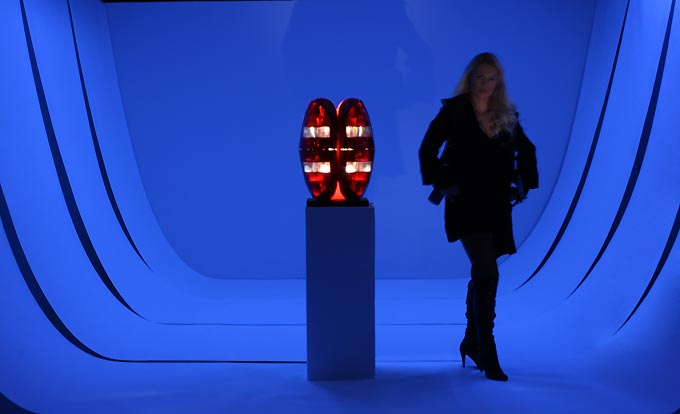
Manabu Shimada
21. Mai 2010
